How to estimate the energy savings from replacing a chiller. In this article we’ll be looking at how to estimate the potential energy savings from replacing a chiller. We’ll look at why to replace an existing chiller, when to replace an existing chiller, how to calculate the savings as well considerations for advanced calculations.
Scroll to the bottom to watch the free video tutorial
See the wide range of Danfoss chiller solutions at http://bit.ly/SolutionsForChillers
Danfoss has a wide portfolio of products to help you boost efficiency in whatever chiller system you’re working with. Their products include compressors, AC drives, system protectors, heat exchangers, valves, electronics, and sensors.
They’re committed to helping you build better chillers — from the inside out. Learn more at http://bit.ly/SolutionsForChillers
As you probably know, chillers are typically the single largest energy consuming piece of equipment within a commercial building. There’s growing pressure on building owners, the building and facilities managers as well as engineers and contracted service companies to reduce energy consumption, carbon emissions and operating costs. As the chiller is typically the largest single energy consumer within the building, it is often looked at for energy efficiency improvements, and rightly so.
In our previous chiller article, we discussed different ways to improve the efficiency of an existing chiller, you can learn about this by clicking here, but in this article we’ll look at replacing a chiller for a newer, more efficient, option.
Why and when to replace a chiller?
Chillers have a typical operational life span of 10-25 years. Their age, condition, criticality and reliability usually play the big part in deciding when to replace a chiller. What should also be considered is the huge savings that can be achieved from the improved efficiency of a replacement chiller with newer technology and also the reduced maintenance costs.
For example, replacing an existing chiller for a Turbocor chiller in many cases is able to cut the annual energy consumption by around 30%, sometimes even higher. The maintenance costs are around 50% less because the Turbocor compressor is oil free so the only maintenance requirements are to change out the capacitors once every five years, tighten the electrical connections once quarterly, and annually dust off and clean the electronic cards. That’s it, no oil replacements, no periodic teardowns, no major overhauls.
We’ve previously discussed how refrigerants work as well as the new regulations coming into effect which will see refrigerants being phased out due to their potential to damage the atmosphere. Some chillers can be retrofitted with alternative refrigerants but the capacity is often hindered because it was not designed to operate at the performance of the new refrigerants which means you’ll almost certainly need to replace some of the components within the system.
How to quantify the energy savings from replacing a chiller
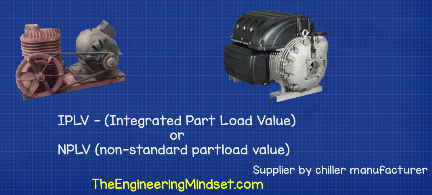
There are many ways to compare the chillers performance, one of the most common ways is to compare the (IPLV Integrated Part Load Value) or NPLV (non-standard partload value) rating. This is supplied by the chiller manufacturer on request or can usually be found in their sales and technical literature.
The IPLV or NPLV is the weighted efficiency of a chiller operating at 100%, 75%, 50% and 25% against a typical amount of time per year at specified conditions defined by ASHRAE in AHRI Standard 550/590. When a chiller is unable to operate at these specifications then it will be rated as NPLV.
There are two types of IPLV depending on whether it was calculated from the COP/EER or kW/Ton, these are just slightly different ways to calculate the efficiency but these will be stated by the manufacturer.
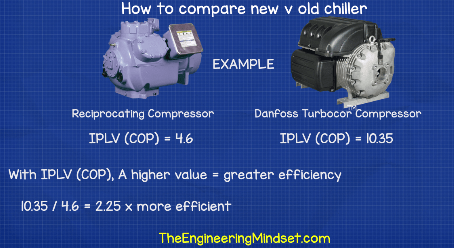
For example, a chiller with a reciprocating compressor might have an IPLV COP rating of 4.6 where as an equivalent Turbocor might have an IPLV COP rating of 10.35. As COP is based on kW of electricity input per kW of cooling output then a higher COP rating means a more energy efficient chiller. So the Turbocor is 2.25 times more efficient than the reciprocating. (10.35/4.6)
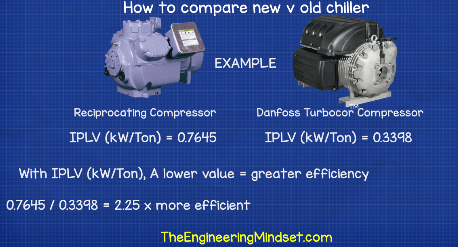
When the IPLV is rated for kW/ton then a lower value means more energy efficiency. The same reciprocating chiller might have an IPLV kW/ton of 0.7645 whereas the Turbocor might have an IPLV kW/Ton of 0.3398 so the Turbocor is 2.25 time more efficient. (0.7645/0.3398)
How to estimate annual energy consumption from a replacement chiller
There are a few ways to calculate this and it depends firstly what the calculation will be used for and what data you have.
It is not recommended to use IPLV or NPLV ratings to estimate the energy consumption for a buildings cooling system as these do not represent the load of the building, only the test data for specific conditions. It is recommended to use building energy analysis programs which are compliant with ASHRAE standard 140, these can model the buildings construction as well as weather data and reflect how the chiller will react.
However, if you’re simply wanting to perform some calculations to obtain a rough estimate of annual consumption for comparative purposes then you can use one or all of the following calculations and we’ll look at examples for each.
- Chiller operating at mainly full load kW/Ton
- Chiller operating mainly at Full load COP
- Chiller operating mainly at part load kW/Ton
- Chiller operating mainly at part load COP
- Chiller based on actual cooling load logs kW/Ton
- Chiller based on actual cooling load logs COP
Fully loaded chiller – estimate the energy savings from replacing a chiller
If you have a chiller that runs at full loading then you can use the following calculations.
To calculate the estimated energy consumption simply multiply the rated capacity of the chiller Tons with the efficiency at full load being in kW/Ton and multiply this by the annual run hours.
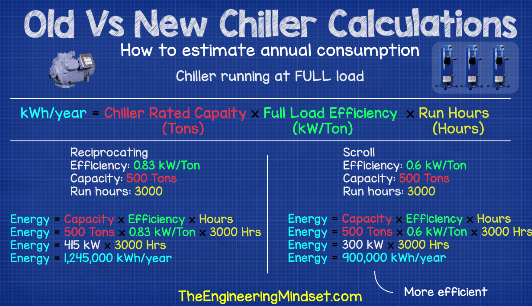
For example, if we compare a reciprocating chiller with a full load efficiency of 0.83 kW/Ton to a scroll chiller with an efficiency of 0.6 kW/Ton, both rated at 500 Tons capacity and run for 3000 hours per year. We see that the reciprocating chiller consumes 1,245,000 kWh/y whereas the scroll chiller consumes 900,000 kWh.
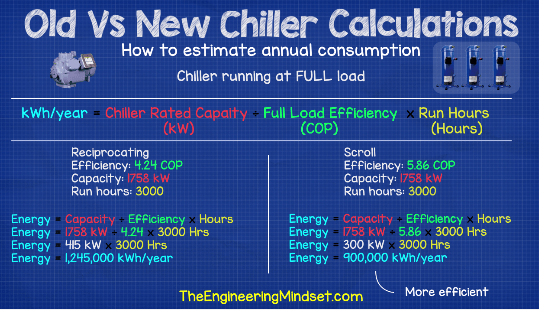
Alternatively, if you have the COP rating you would simply divide the chiller capacity, rated in kW, by the COP then multiply this by the operating hours per year. So to compare two chillers rated at 1758 kW. The first, a reciprocating chiller with a COP of 4.24 and the second a scroll chiller with a COP of 5.86, both units run for 3000 hours per year, then the estimated annual consumption would be equal to 1,245,035 kWh for the reciprocating chiller and 900,207 kWh for the scroll chiller.
Variable load chiller – estimate the energy savings from replacing a chiller
If you have a chiller with a variable load, which is far more likely, then you can use the following method.
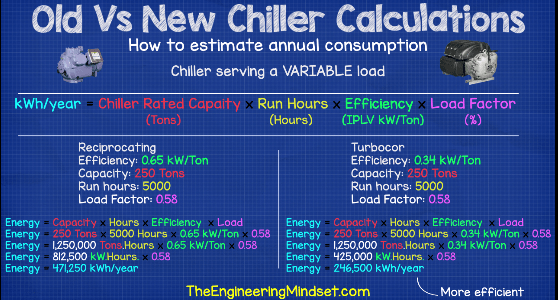
If you have the IPLV kW/Ton value then you can use the following method. To calculate the estimated annual kWh consumption then take the cooling capacity Ton rating of the chiller and multiply this by the annual operating hours per year then multiply this by the efficiency IPLV kW/Ton value and then multiply this all by the average loading factor which is likely around 0.6.
For example we’ll compare a Turbocor chiller with an IPLV of 0.34 to a reciprocating chiller with an IPLV of 0.65. Both units are rated at 250 tons with an average load factor of 0.58 and operate for 5000 hours per year.
So, if we drop the numbers in, you can see the Turbocor comes out at 246,500 kWh/y whereas the reciprocating chiller comes out at 471,250 kWh/y resulting in a saving of 224,750 kWh/y.
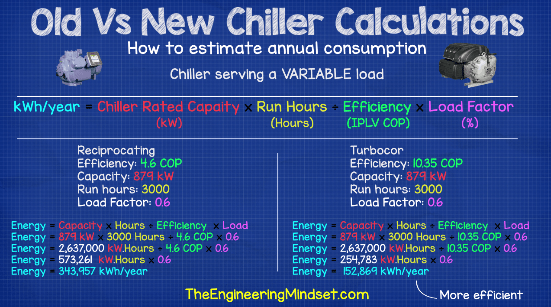
If you have the IPLV COP value then you can use the following method. To calculate the estimated annual kWh consumption, take the cooling capacity rated in kW and multiply this by the operating hours per year, then divide this by the efficiency IPLV value and the multiply this by the average load factor.
For example, we’ll compare a turbocor chiller with an IPLV of 10.35 to a reciprocating chiller with an IPLV of 5.409. Both have an average load factor of 0.58 and a run time of 3,000 hours per year.
To calculate this we need to take the chillers rated capacity (kW) and multiply this by the run hours per year, then divide it by the IPLV COP efficiency and multiply this by the average load factor.
Dropping these numbers in we can see the reciprocating chiller consumes 343,957 kWh/y per year whereas the Turbocor consumes 153,000 kWh/y.
Historic data modelling – estimate the energy savings from replacing a chiller
For a better and more accurate comparison for replacing an existing chiller you can log the cooling load profile and energy consumption at intervals, hourly should be fine, and record this over a number of months or a year. The longer the better. Then using the part load efficiency data for any potential replacement chiller, you can calculate and compare the estimated energy consumption of different chillers to see the potential savings. Lets have a look at a simplified example for a daily load profile.
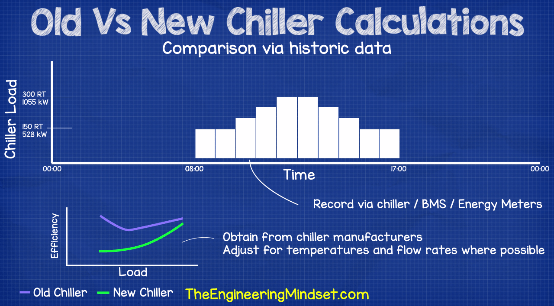
From the chiller log we can obtain the daily cooling load in RT and see that the chiller runs for 10 hours per day between 8am and 5pm. Then we need the efficiency of both the existing and new chiller. In this example we’ll use kW/Ton. By multiplying the efficiency by the cooling load, we get the hourly kWh consumption.

Then we can see that the existing chiller would consume 1,378 kWh a day whereas the new potential chiller would consume 980 kWh a day resulting in a saving of 398 kWh. If the chiller runs 5 days a week for 52 weeks per year then the replacement chiller would save 103,480 kWh per year compared to the existing chiller.
If you have the cooling load in kW then you should use the chiller COP to calculate the hourly electricity consumption. For this you carry out the same analysis to find the chillers efficiency for the chiller loading from the chiller manufacturer except this time you divide the cooling load by the COP value to calculate the hourly consumption. Again, following this we can see that the replacement chiller would produce significant savings.
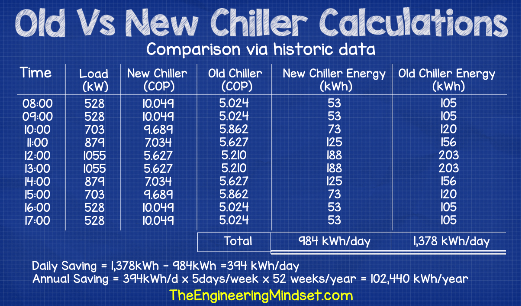
As I said this is an overly simplified example, in the real world the chiller load will change through the seasons and would likely run much longer hours so you would need to account for this, basing the annual performance on a single week is not sufficient.
Additional considerations
- To calculate the financial savings, you need to consider the electricity tariff of the building as this will most likely vary throughout the day and year.
- There might also be savings from reducing your peak load electrical demands and reductions from associated carbon emissions penalty charges.
- More complex financial models should incorporate inflation rates for the tariffs.
- Savings can also be quantified for reduced pumping costs due to a reduction in pressure drop across the chillers evaporator and condenser.
- Lastly you should obtain quotations for maintenance and materials of the new chiller and include any reduction within the financial model.
- For payback you need to account for the cost of the chiller as well as the removal, disposal, installation and commissioning for the new unit from a contractor.

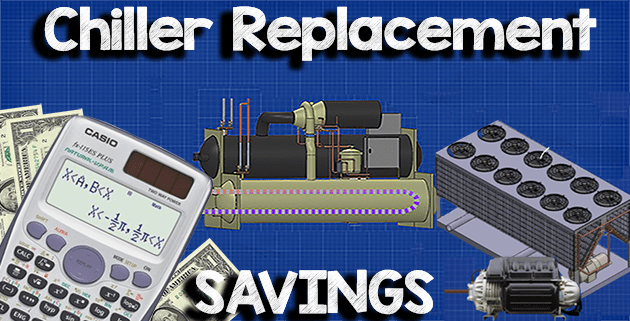
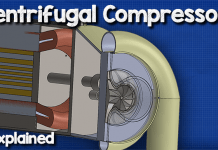

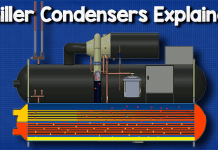














How to compare two chillers if the new one is of a higher Capacity then the older one . Need help urgent .
Dear sir
i would like requested you to please share comparison of payback cost of new chiller installation work, for example new chiller investment cost is 5500$ and installation cost is 3000# please share payback time period
Regards
Nadeem
It is very nice and helpful to understand the comparison of existing & new chiller consumption.